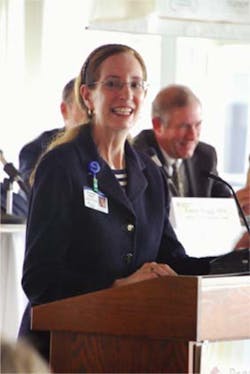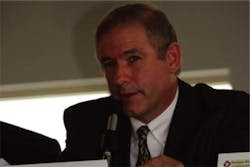Dr. Jay Naliboff of Franklin Memorial Hospital using the HealthInfoNet system on his computer, Franklin Memorial Hospital
In the past year, the health information exchange (HIE) market has exploded with new, promising exchanges. One particularly innovative HIE that caught the eye of this magazine is HealthInfoNet (HIN), Maine's statewide HIE, whose innovative approach earned it recognition by Healthcare Informatics' editors as the first HIE to be recognized as a finalist Innovator organization. HIN has a breadth and depth that most HIEs would find enviable. It currently connects 15 hospitals, one primary care organization, and close to 1,200 individual users-about 50 percent of all clinical care activity in Maine. It hopes to increase that number to 80 percent by 2014.
Wendy Wolf, M.D., M.P.H., whose organization the Maine Health Access Foundation partially funded HIN, was an early supporter of health information exchange in Maine. She remembers how impressed David Blumenthal, M.D., the National Coordinator for Health Information Technology, Office of the National Coordinator, was when he came to Portland to kick off HIN's demonstration phase. “He said, ‘My gosh, I come from Boston where I'm at a hospital that can't talk to the hospital across the street, and you guys are talking to hospitals across Maine, which is as big as all northern New England,’” says Wolf.
HealthInfoNet has a fairly robust clinical data set based on the continuity of care record (CCR), which includes personal identification, allergies, prescription medication, lab and radiology results. At the present time, HIN is exchanging only printed results-diagnosis, visit history, problem lists from the ambulatory space, and other transcribed notes-with images to be shared later.
Catherine Bruno, CIO, Eastern Maine Healthcare Systems (Brewer), and executive sponsor of the Bangor Beacon Community Grant, finds a particular need for health information exchange in the middle of the state where there are several different hospitals. “It's most useful because you're most likely to see information that's different than what you see in your own organization's electronic health record,” she says. “It's most heavily used in places where there are competing health care organizations.”
John Vogt, a pediatrician at the 20-physician Martin's Point Health Care Center in Portland, uses HIN weekly when a patient is seen elsewhere and he hasn't received that patient's documentation via fax. “For example, a patient was in a serious MVA [moving vehicle accident] on Sunday. I learned about it 7 a.m. on Monday, and was able to go into HIN and see that he had been admitted to Central Maine Medical Center. And I could see all of the history and physicals, the operative reports, the CT, and MRI scan reports, as well as all of his lab.”
STEP BY STEP
HealthInfoNet was one of the industry's earliest health information exchanges. As Jim Harnar, the first project leader for HealthInfoNet and the current executive director of the Portland-based Daniel Hanley Center for Health Leadership, describes it, the leadership in 2004 was playing a little catch-up, just having missed the boat on federal grant funding. After watching a number of more underprepared states launch HIEs and fail, Wolf agreed to step forward with her foundation, the philanthropic Maine Access Foundation in Augusta, and two other state agencies, the Maine Center for Disease Control and Prevention (Augusta), and an organization that at that time was called the Maine Health Information Center (now the Manchester-based Onpoint Health Data), to fund a feasibility study in mid-2004. In the fall of 2004, all state hospitals sent letters in support of the HIE, and the Manchester-based Maine Medical Association leadership voted to move forward with the feasibility study. “That early support from the primary organization representing most of the physicians in the state was really important in giving our initiative a stamp of approval,” says Harnar.
Harnar attributes his colleague John Fields, a consultant who led the feasibility study and who was previously an executive at Central Maine Medical Center in Lewiston, with spurring his and others' “aha” moment with the project. “John said this isn't a health IT project; this is a patient safety, quality of care initiative that happens to require a lot of IT,” Harnar says. “The light bulb went on in my head and from that point forward we started to position the initiative as such.”
THE KEY TO SUCCESS IS THAT WE NEGOTIATED A RELATIONSHIP WITH THE VERY COMMUNITY THAT WAS THE MOST SENSITIVE TO THE CONCEPT, AND THAT ALLOWED US TO STAY EFFICIENT.-DEVORE CULVER
ENGAGING THE CRITICS
After the feasibility study, stakeholder engagement was solidified in 2005, with the CEOs and CIOs of Maine's major hospitals. The group made the determination that the HIE would be built upon a central data repository, for efficiency. Consumer groups that were most sensitive to privacy concerns with health information exchange, like the American Civil Liberties Union, Planned Parenthood, and mental health and HIV/AIDS activists, were engaged early on.
Following the study, a long and challenging debate ensued about whether HealthInfoNet would be an “opt-in” or “opt-out” exchange. The HIN leadership knew they wouldn't get a critical mass if they didn't have an “opt-out” strategy, but they did give a major concession to consumer groups-when someone opts out of HIN, they are entirely removed from the database, instead of just having their information hidden. HealthInfoNet's Executive Director Devore Culver says it also makes it a lot easier for providers that way, and HIN creates a daily audit of opt outs. “The key to success is that we negotiated a relationship with the very community that was the most sensitive to the concept, and that allowed us to stay efficient,” he adds.
After engaging providers, consumers, and others, the actual planning process started in 2005 with the creation of HIN's core principles, while workgroups put together the first technical specifications for the exchange. Fast forward to last June as HIN finished its two-year demonstration phase with the state's six major healthcare organizations, which represents facilities all over the state of Maine. Four of them are the four large delivery systems in the state, one is a small, independent, rural hospital, and one is an ambulatory group practice with multiple locations around the state. The sites were strategically chosen to find out how difficult it would be to link large disparate delivery systems, as well as rural hospitals, and to also understand the process around group practice workflow.
BEDROCK OF TRUST
Culver believes the chief reason for HIN's success is the bedrock of trust that his organization rests on. “It starts with a framework of collaboration and trust that are the foundation of what make it a truly effective exchange,” he says. HIN's board of directors includes representation from consumers, providers, payers, business, and state government that have been carefully designed to bring to the table a set of critical stakeholders, according to HIN board member David Howes, M.D., president and CEO, Martin's Point Health Care.
The stakeholder model is nothing new, but getting healthcare organizations to relinquish their rein over patient data is rather progressive. Maine Health Access Foundation's Wendy Wolf cites an early pivotal decision was to have a philosophy that nobody wins unless everyone wins. “That was really important because we had every major hospital with different systems and they certainly weren't aligned, and we said we're not going to default to the biggest health system,” Wolf says. “Everyone is going to agree that we're going to hold hands and go through this together, so at the end everyone benefits.”
That all-for-one, one-for-all mantra helped HIN to easily proceed with a best-of-breed technology strategy. No one vendor that did what HIN needed and most health systems had disparate systems, so an enterprise approach wasn't really possible. That was another reason HIN decided to undergo a demonstration phase, to truly assess the technical infrastructure.
DATA TRUST, STANDARDIZATION
Besides trusting the players in an HIE, having trust in the data is also of paramount concern. After the demonstration phase ended last June, HIN sent users a qualitative survey to rank their trust in data. Scores were incredibly high, according to Culver. “The reason why is their respective teams that were engaged early in the project in 2008 came to trust each other too, and that sort of carries forward in communicating the value of the system to the people they're educating to use it,” he adds.
Another key to HIN is true standardization within the centralized data repository. With new, more diverse organizations coming onboard, the best way to sustain an HIE, according to Culver, is not only to move patient information, but to standardize it to lead to greater opportunities for use. “Our mission is to standardize content wherever we can, so the key there is that the data itself has more value than simply transport for treatment,” Culver says. “If you can't look at data comparatively across organizations, then you're losing a huge value proposition.”
Culver describes the importance of standardization with HIN's mandated disease reporting to the Maine Centers for Disease Control and Prevention by delivering results based on Logical Observation Identifiers Names and Codes (LOINC). “That LOINC code actually plays a critical role for a number of things we want to accomplish, including building out inter-organizational clinical decision support,” he says. “Also, my wildest dream two or three years from now is getting the ordering systems from these organizations to point to the exchange, so that during this process of ordering a test, a provider can see a result that is relevant and available.”
SUSTAINABILITY AND BEYOND
The next step for HIN will be providing robust analytics for its providers. Culver notes that healthcare analytics provide the only true patient view and will be fundamental for accountable care organizations (ACOs) that will be compensated based on the total well-being of their patients. Culver also sees future non-commercial uses within the healthcare community for the patient information database, but is being tight-lipped on these alternate revenue streams until closer to their launch.
Culver sees sustainability in the exchange graduating from just moving data from point A to point B. “It's a space where no one was paying for it before, so why the heck would they pay for it now,” he says. “At this date we're still working from a business model that assumes that the providers pay about a third of the cost, so that's very high incentive for us to go and figure out how to find the other two thirds.” Culver also sees opportunity in engaging other healthcare sectors like payers, that don't typically pay for HIEs now.
Eastern Maine's Cathy Bruno says another key to HIN's sustainability is the need for organizations to exchange patient information to meet meaningful use. “Stage 1 of meaningful use only requires us to be capable of exchanging information,” she adds. “Stage 2 we're going to have to be exchanging information, so the logical place to share information in Maine is through HealthInfoNet.”
BANGOR BEACON COMMUNITY INVOLVEMENT
HIN is now intricately involved with the Bangor Beacon Community, one of the 17 federally-funded Beacon Communities that launched last fall. The Bangor Beacon Community is a collaboration of 12 partners in the Bangor metropolitan area and will focus on improving the health of chronically ill patients through the use of care management facilitated by health information technology, says Bruno, the executive sponsor for the Bangor Beacon Community Grant.
Forty-three Bangor Beacon care managers, 10.5 of whom are fully funded by the grant, will be helping on average 65 to 80 patients each to manage their chronic diseases. By November 2011 all the Bangor organizations, which include three hospitals, two ambulatory practices, one cardiology practice, one community health center, and three home health sites, will come online with HealthInfoNet.
HIN will also be instrumental in the exchange and coordination of data and video for the Bangor telemedicine program that will include 75 telemedicine units that monitor patients' vital stats like weight and blood pressure. This information is now uploaded to a secure Web site that is monitored by the care managers, who manually enter the information into the patient's EHR; but the Beacon Grant will facilitate a direct feed of data from the patient's home medical monitor equipment through HIN to the patient's EMR.
Another piece of the Bangor initiative will be populating adult pneumonia and flu immunizations in the Maine immunization registry. In order to collect data through HIN to use in state reported immunizations per meaningful use, HIN will have to get broader engagement from retail pharmacies, which have never been in the workflow before. This will involve linking them to the exchange through a secure messaging structure.
ON THE HORIZON
There are many prospects on the horizon for HealthInfoNet: connecting the remaining 50 percent of the state, robust analytics, population health tools, and possibly a personal health record. But whatever comes its way, this HIE's foundation seems rock-solid enough to weather any challenge ahead. “[There are] so many opportunities to use this data to manage health system development,” says HIN board member David Howes. “It's potentially useful for benchmarking, and it's incredibly useful for managing and leading quality improvement in our healthcare delivery system.”
Harnar adds: “We view HealthInfoNet as a textbook example of effective collaboration among competing organizations and interests to develop a system to benefit the entire state.”
Healthcare Informatics 2011 February;28(2):21-24




